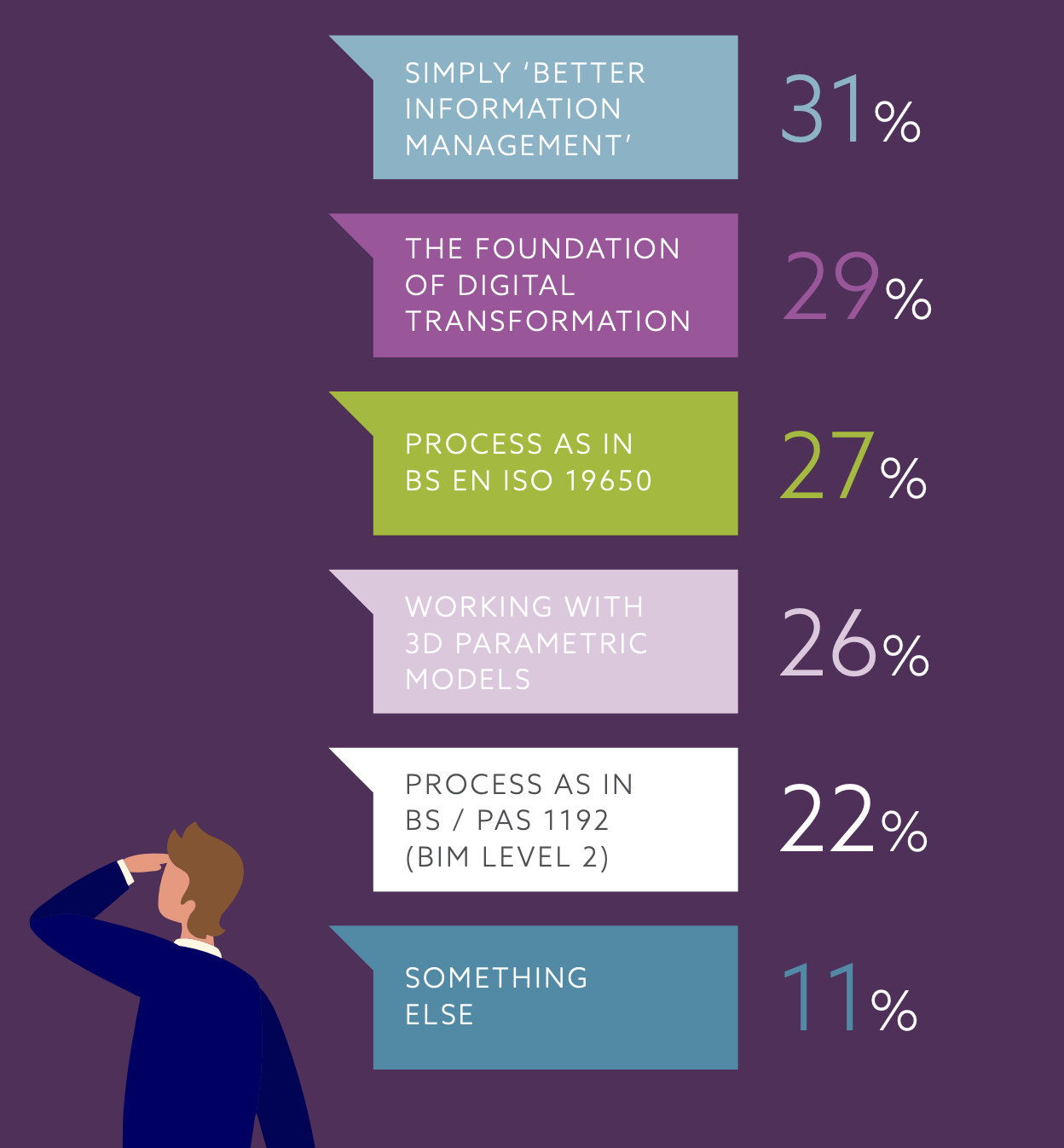
The meaning of BIM is still unclear, according to the latest digital construction report from NBS in association with Glenigan.
The more than 700 professionals (nearly three-quarters from the UK) in the survey were divided on the meaning of BIM. Asked “how would you describe BIM in 2023?” nearly a third (31%) said it was “simply better information management”, while a similar percentage (29%) thought it was the foundation of digital transformation. More than a quarter (27%) saw BIM as a process relating to ISO 19650, while a similar percentage (26%) saw it as working 3D parametric models. Nearly a quarter mentioned the outdated PAS 1192/BIM level 2 [respondents could pick more than one definition – ed].
Further analysis reveals that smaller organisations, of 25 staff or fewer (17%), are less likely to see BIM as following a set of standards. And, unsurprisingly, it’s the BIM specialists who are most likely to see BIM in terms of ISO 19650 (55%). They are also most likely to view it as better information management (38%) and the foundation of digital transformation (41%).

BIM adoption levels are static at 70%. Since 2018, NBS’s survey results show adoption levels varying between 69% and 73%. There are some differences between roles in the latest survey, with adoption rising to 73% among consultants while, perhaps unsurprisingly, it is lower (53%) for clients.
Size matters
There remain large differences relating to organisation size: BIM adoption drops to 60% among organisations with 25 or less staff, and 56% for those with 15 staff or less. Age has an impact too, with those over 55 less likely to have adopted BIM (59%), and more likely to have no plans to (22%).
An architectural assistant at a medium-sized architectural practice told NBS: “I think there is generally a knowledge gap between senior construction professionals and junior staff using BIM software full-time, making it harder to calculate the level of resource required to deliver a certain level of [detail/information]. If BIM as a process was more inclusive of all team members, especially in small to [medium-sized] businesses, everyone might better understand what they’re signing up to when they take on contracts with BIM as a deliverable.”
NBS said: “There are some who feel that much of the industry has now adopted BIM, implying that there is a limited need to continue discussing it. However, the many comments in this survey debating its effectiveness, and that of digital technologies generally, suggest that it is still very much a live discussion.
“While a lot of work has gone into mapping out a process that many have followed, often on large projects, the challenge now is applying the right version of it effectively on projects of all types and sizes, and in a way that benefits all the project team, and the full range of construction projects: large and small; new and refurb; and conservation, landscape, infrastructure and buildings.”
Sharing information
Over three-quarters of respondents (77% – up from 73% in the last survey) said that their organisation follows a naming convention for all information that is shared. More than half (56% – up from 50%) exchange information in IFC, and 36% (up from 31%) in COBie. There was an appreciable increase in those using NBS’s Uniclass classification system: 39% of respondents to 49%.
NBS also asked respondents about how digital technology is being used to calculate specific metrics relating to environmental sustainability. More than two-thirds (67%) stated that they use digital tech to calculate at least one metric: most commonly, these are embodied carbon (40%) and energy demand (38%). Almost a third (32%) use it to undertake lifecycle analysis, and just under a fifth to calculate water use demand (19%) and waste (18%).
Immersive technology was also under the microscope. More than a third (36%) said they already use some form of immersive technology, while another 20% plan to use it within three years.
Of those already using immersive technology, nearly three-quarters (74%) are using it for stakeholder engagement such as walk-throughs. Nearly two-thirds (62%) are using it to visualise how designs interface with their surroundings. More than half are using immersive technology for clash detection during design and construction.
Don’t miss out on BIM and digital construction news: sign up to receive the BIMplus newsletter.
Comments
Comments are closed.













I do wonder how arbitrary this is. There are many terms with definitions, some huge like “Religion” or “politician”, but if you were to ask a hundred people what they meant & simply categorised the differences in their responses rather than the similarities, this is what you get & its not helpful because all of them are kind of true so why dawn on it.
BIM is such a misleading term that has become distorted by marketing, both commercial and corporate badging. Perhaps we should go back to the origin of need which was Project Information Managements (PIM). It was simply to manage the delivery of design, construction and information to produce the best value project and the ability to manage the in use business of the client. it was intended to remove waste and bad practices by using the emerging technologies coupled to new ways of working. To do what we were suppose to do but do in right first time. We should also remember the ‘outdated PAS 1192/BIM level 2 and BS1192; without them there would not have been an ISO 19650. The research that delivered those standards proved that PIM was capable of delivering better profits for all and a better outcome for the client. The report does not make any reference to proof that ‘BIM’ can achieved this with the use of the current standards. There is no standard education or training requirements, all we have are ‘experts’ constantly suggesting different methods , ‘I have a better way of doing it or my version.. One comment that stands out is ‘the level of resource required to deliver a certain level of [detail/information].’ demonstrates a lack of knowledge and a lack or experience. This is an all inclusive activity with many actors, it is the term ‘BIM’ that has made it elitist.